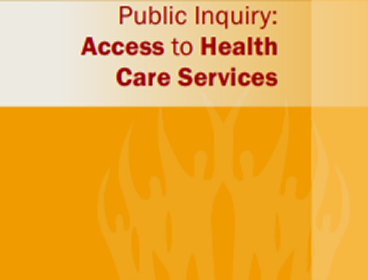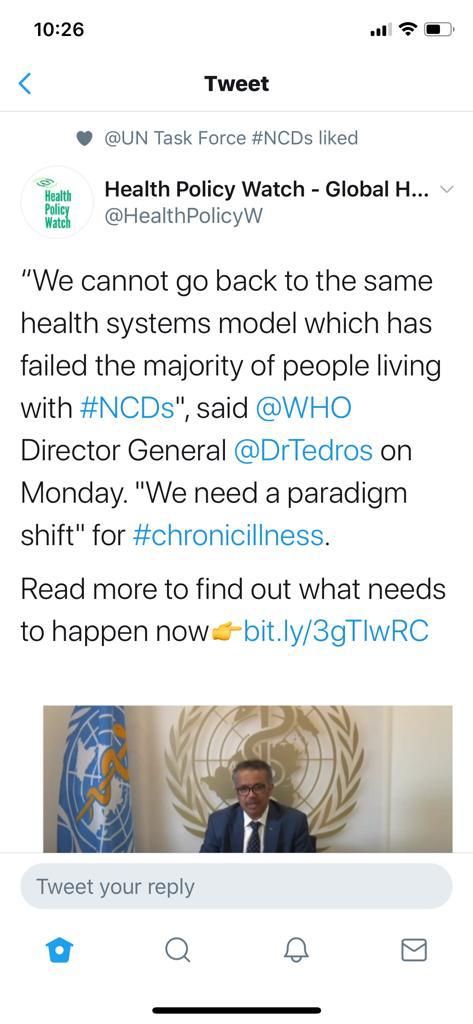
Early in the COVID-19 pandemic WHO’s @DrTedr os highlighted the problems of access to health services by millions of people living with NCDs+ in his tweet. His tweet certainly mirrors what the SA NCDs Alliance and our allies have been saying since 2007 when the SA Human Rights Commission (SAHRC) held its first public hearings into the right access to health services.
os highlighted the problems of access to health services by millions of people living with NCDs+ in his tweet. His tweet certainly mirrors what the SA NCDs Alliance and our allies have been saying since 2007 when the SA Human Rights Commission (SAHRC) held its first public hearings into the right access to health services.
COVID-19 changed the parameters of vulnerability to include NCDs+, mental health, and reemphasised disability in all its shapes and forms.
SAHRC report 2007
15 years ago the primary focus was understandably on access to HIV/AIDS and TB services. It was the height of the communicable disease epidemic. And amidst our homegrown “AIDS-denialism”. It was also the midpoint of the Millenium Development Goals (MDGs) where vast amounts of funding were channelled into communicable diseases and maternal-child services. That pattern of expenditure and funding remains in place today.
Executive summary
The report’s executive summary is salutary: it fits today’s health service access issues in the COVID-19 pandemic. Just substitute NCDs+ for communicable diseases. And, we have a similar complaint today.
The report’s opening quote is ironically, but not surprisingly, from The AIDS Law Project, the early version of Section 27:
“We don’t yet have a definition of essential health services. This means we don’t have a base line for the right to health and it is impossible to cost the health service and thereby determine objectively what can be
afforded.”
We still don’t have the definition. But HIV unlike NCDs+ is a National Development Plan priority. As for the rest of the conclusions, they mostly are unmet PLWNCDs+ The main change to health services is that HIV/TB services dominate primary health care. We beg for evidence-based inclusion of NCDs + throughout the life-course. And, more not just a tack on to HIV, TB and STI services.
That is why we fight on. Read the SAHRC 2007 report on access to health services SAHRC 2007Health Report
Summary: 1st WHO essential diagnostic list focusing on mainly communicable diseases with a recommendation to include more NCDs in a future edition. PHC and facility level essential package. Vicki Pinkney-Atkinson
Improving NCDs diagnosis & treatment outcomes
Today, many people are unable to get tested for diseases because they cannot access diagnostic services. Many are incorrectly diagnosed. As a result, they do not receive the treatment they need and, in some cases, may actually receive the wrong treatment.
For example, an estimated 46% of adults with Type 2 diabetes worldwide are undiagnosed, risking serious health complications and higher health costs. Late diagnosis of infectious diseases such as HIV and TB increases the risk of spread and makes them more difficult to treat.
Essential Diagnostics List (EDL)
To address this gap, WHO today published its first Essential Diagnostics List (EDL), a catalogue of the tests needed to diagnose the most common conditions as well as a number of global priority diseases.
“An accurate diagnosis is the first step to getting effective treatment ….No one should suffer or die because of a lack of diagnostic services, or because the right tests were not available.”
Dr Tedros Adhanom Ghebreyesus, WHO Director-General.
The list concentrates on in vitro tests – i.e. tests of human specimens like blood and urine. It contains 113 products: 58 tests are listed for detection and diagnosis of a wide range of common conditions, providing an essential package that can form the basis for screening and management of patients. The remaining 55 tests are designed for the detection, diagnosis and monitoring of “priority” diseases such as HIV, TB, malaria, hepatitis B and C, human papillomavirus and syphilis.
Some of the tests are particularly suitable for PHC facilities, where laboratory services are often poorly resourced and sometimes non-existent; for example, tests that can rapidly diagnose a child for acute malaria or glucometers to test diabetes. These tests do not require electricity or trained personnel. Other tests are more sophisticated and therefore intended for larger medical facilities.
“Our aim is to provide a tool that can be useful to all countries, to test and treat better, but also to use health funds more efficiently by concentrating on the truly essential tests,” says Mariângela Simão, WHO Assistant Director-General for Access to Medicines, Vaccines and Pharmaceuticals. “Our other goal is to signal to countries and developers that the tests in the list must be of good quality, safe and affordable.”
For each category of test, the EDL specifies the type of test and intended use, format, and if appropriate for primary health care or for health facilities with laboratories. The list also provides links to WHO Guidelines or publications and, when available, to prequalified products.
Similar to the WHO Essential Medicines List, which has been in use for four decades, the EDL is intended to serve as a reference for countries to update or develop their own list of essential diagnostics. In order to truly benefit patients, national governments will need to ensure appropriate and quality-assured supplies, training of healthcare workers and safe use. To that end, WHO will provide support to countries as they adapt the list to the local context.
The EDL was developed following an extensive consultation within WHO and externally. The draft list was then considered for review by WHO’s Strategic Advisory Group of Experts on In-Vitro Diagnostics – a group of 19 experts with global representation. For more information see WHO website.
WHO will update the Essential Diagnostics List on a regular basis. In the coming months, WHO will issue a call for applications to add categories to the next edition. The list will expand significantly over the next few years, as it incorporates other important areas including antimicrobial resistance, emerging pathogens, neglected tropical diseases and additional NCDs.
Numbers don’t lie, especially if you take a look at the place of NCDs in the draft health budget. The words about NCDs imply commitment to solving a huge health problem. That is superficial though when it comes to NCDs. There a heaps of great sounding words (policies and plans) but a clear lack of money. Especially for screening and treatment. Words, even printed ones, are cheap. Little has changed:
Whilst the Minister in the preamble of the Annual Performance Plan highlights importance of tackling non-communicable diseases (NCDs) there doesn’t appear to be any dramatic shift in budget allocation over the Medium Term. Can the department provide reasons for this?
Issues for consideration Parliament Research Unit. Vote15: Health Budget 2014/15 p.6
Health is allocated less than 5% of the proposed national budget (Figure 1). Defense get more yet SA loses more people to NCDs each day than in armed conflicts. Where are our national priorities?

Figure 1:
Looking at the details of the health budget

The smallest by far is Programme 4 for Primary Health Care (PHC) services (R 225 -million)
Most People Living With NCDs get care at primary health care (PHC) clinics and this appears to be the reasoning why NCDs are placed within Prog 4 . People living with HIV/AIDS
Our information comes from the draft Annual Performance Plan (APP) and its accompanying budget. – see pages 61-63. Click here to download the draft APP 2015/2016-2017/8
Fast facts stacking up Programme 4 vs other NDoH Programmes 2015/16
Smallest programme
budget by far |
See Figure 2 |
| 1st place people costs |
Programme 4 cost of PEOPLE EMPLOYED R186.2 million = ↓ money available for implementation |
2nd largest # people
employed |
458 by only 10 people short of no 1 placed Programme 1 (p. 27) |
| Only programme to increase personnel costs |
Leaving less to spend on implementing programmes/ plans |
3 NCDs issues related to HIV/AIDS and Maternal Child health appear in Prog 3 budget (cancer cervix, breast cancer policy, immunizations.) Cancer of the prostate does not warrant a mention in the APP.
The key to the APP is words not allocation of funds. Again NCDs screening and treatment is left high and dry.
Fast facts about NCDs Prog 4 budget
Where is the money for implementation of the NCDs plan in this budget?
| 89.37% for people working on projects – personnel, contractors and consultants |
0 for screening of target of 8 million people for high BP and blood glucose OR
NCDs Commission/ Health Commission (more next week on this) |
1.3 % NGOs or non-profits (< R 3-million) > 50% goes to 2 of 6 NGOs
National Council Against Smoking & SA National Council for the Blind. |

NCDs prevention and treatment cross cuts all Programmes especially at the PHC level. So we need to look at inside other programmes. However, without exception there is no separate financial allocation for stated NCDs targets like for example breast cancer policy development and cancer of the cervix screening in Programme 3 (HIV/AIDS & TB.) Innovations like “ideal clinics” which are supposed to include NCDs take place without consulting NCDs civil society organisations.
Examples from Programme 2: NHI
- Drug procurement and stock out management (all drugs including ARVs)
- National Cancer Registry (words no money)
Programme 3: HIV/AIDS & TB
- Cervical cancer screening
- Breast cancer policy (more words no money)
- Vaccinations against hepatitis & human papilloma virus
- Obesity policy (more words no money)
Watchdogs must bark. An NCDs advocacy series. This is the first in a series on NCDs in policy documents.

 os highlighted the problems of access to health services by millions of people living with NCDs+ in his tweet. His tweet certainly mirrors what the SA NCDs Alliance and our allies have been saying since 2007 when the SA Human Rights Commission (SAHRC) held its first public hearings into the right access to health services.
os highlighted the problems of access to health services by millions of people living with NCDs+ in his tweet. His tweet certainly mirrors what the SA NCDs Alliance and our allies have been saying since 2007 when the SA Human Rights Commission (SAHRC) held its first public hearings into the right access to health services.


